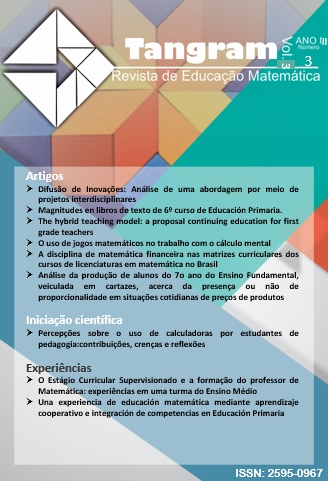Project-based learning and diffusion of innovations: a study with high school students
DOI:
https://doi.org/10.30612/tangram.v3i3.7304Keywords:
Diffusion of Innovations. Interdisciplinary Projects. GeoGebraAbstract
This article presents a qualitative research involving three classes of high school students from a brazilian public school. On the development of an interdisciplinary project of Mathematics and Portuguese Language, analyzed under the theoretical framework of the Theory of the Diffusion of Innovations. We intend to discuss the possible contributions of an approach through projects of apparently distant curricular themes, such as trigonometric functions and the literary aesthetic of Romanticism, highlighting the use of the application for GeoGebra smartphones. In this case, the connection between these two disciplines was established through music. Technological mediation took place through access to music, videos, poems and, above all, by the exploitation of GeoGebra's algebraic and geometric resources. At the end of the project, we consider the positive experience, both in the attitudinal aspects, as the mobilization of interest and motivation of the students, as well as in the cognitive aspects, expressed by the quality of the final products of their researches presented.Downloads
References
Abar, Celina Aparecida Almeida Pereira. (2014). Geogebra: na produção do conhecimento matemático. São Paulo: Iglu.
Abar, Celina Aparecida Almeida Pereira. (2017). Model of Innovation: Process of Integrating Technology in Mathematics Education. Acta Scientiae, 18 (3), 1 - 12.
Brasil. (2000). Secretaria de Educação Média e Tecnológica. Parâmetros curriculares nacionais (Ensino Médio). Brasília: Ministério da Educação e Cultura.
Bulegon, Ana Marli & Trevisan, Maria do Carmo Barbosa. (2016). O uso do GeoGebra, Funções Trigonométricas e sons musicais como recursos motivacionais para o ensino de Acústica no ensino médio. Anais da 6ª LACLO - Conferência Latino Americana de Objetos de Aprendizagem.
Christe, Ian. (2010). Heavy Metal: a história completa. Tradução de Milena Durante e Augusto Zantoz. São Paulo: Ed. Arx.
Creswell, John. W. (2010) Projeto de pesquisa métodos qualitativo, quantitativo e misto. Porto Alegre: Artmed.
Faria, Elisabeth Cristina de. (2012). Do ensino presencial ao ensino à distância: a inovação na prática pedagógica de professores de Matemática. Tese de Doutorado em Educação Matemática. São Paulo: Pontifícia Universidade Católica de São Paulo.
Faria, Elisabeth Cristina & Abar, Celina Aparecida Almeida Pereira. (2011). A Difusão de Inovação em um curso de Licenciatura em Matemática na modalidade a distância. Anais do 10º Encontro de Pesquisa em Educação da Região Sudeste. UFRJ.
Fazenda, Ivani. (2008). O que é interdisciplinaridade. São Paulo: Cortez Editora.
Fux, Jacques. (2013). Literatura e matemática: Jorge Luis Borges, Georges Perec e o Oulipo. Petrópolis: KBR Editora.
Giacomini Filho, G.; Goulart, E. E. & Caprino, M. P. (2008). Difusão de inovações: apreciação crítica dos estudos de Rogers. Revista Famecos, 14 (33), 41- 45.
Machado, Nilson José. (1993). Matemática e Língua Materna. São Paulo: Editora Cortez.
Machado, Nilson José. (2004). Educação: projetos e valores. 5. ed. São Paulo: Escrituras.
Porciúncula, Mauren & Samá, Suzi. (2015). Projetos de aprendizagem: uma proposta pedagógica para a sala de aula de estatística. In. Samá, Suzi. & Porciúncula, Mauren (orgs.): Educação estatística: ações e estratégias pedagógicas no ensino básico e superior. Curitiba: CRV.
Reginatto, Junior J. & Menoncini, Julia. (2016). Série de Fourier e Aplicação. Recuperado de https://docplayer.com.br/14991856-Serie-de-fourier-e-aplicacao.html
Rogers, Everett Mitchell. (2003). Diffusion of Innovations. 5th ed. New York: Free Press.
São Paulo. (2010). Proposta curricular do Estado de São Paulo: Língua Portuguesa. São Paulo: SE/CENP.
São Paulo. (2012). Currículo do estado de São Paulo: Códigos, Linguagens e suas tecnologias: ensino fundamental ciclo II e ensino médio. São Paulo: SE/CENP.
São Paulo. (2014). Proposta curricular: caderno do aluno – ensino médio: matemática. São Paulo: IMESP.
Rezende, Wanderley Moura; Pesco, Dirce Uesu; Bortolossi, Humberto José. (2012). Explorando aspectos dinâmicos no ensino de funções reais com recursos do GeoGebra. Revista do Instituto
GeoGebra Internacional de São Paulo, 1 (1), 74-89.
Severino, Antônio Joaquim (2007). Metodologia do trabalho científico. São Paulo: Cortez.
Soares, Magda. (2003). Letramento e escolarização. In: Ribeiro, Vera Masagão (org.): Letramento no Brasil. São Paulo: Global, 89 - 113.
Tomaz, Vanessa Sena; David, Maria Manuela Martins Soares. (2012). Interdisciplinaridade e aprendizagem da matemática em sala de aula. Belo Horizonte: Autêntica.
Downloads
Published
How to Cite
Issue
Section
License
Authors must accept the publication rules when submitting the journal, as well as agree to the following terms:
(a) The Editorial Board reserves the right to make changes to the Portuguese language in the originals to maintain the cultured standard of the language, while respecting the style of the authors.
(b) Authors retain the copyright and grant the journal the right to first publication, with the work simultaneously licensed under the Attribution-NonCommercial-ShareAlike 3.0 Brazil (CC BY-NC-SA 3.0 BR) that allows: Share - copy and redistribute the material in any medium or format and Adapt - remix, transform, and create from the material. CC BY-NC-SA 3.0 BR considers the following terms:
- Attribution - You must give the appropriate credit, provide a link to the license and indicate whether changes have been made. You must do so under any reasonable circumstances, but in no way that would suggest that the licensor supports you or your use.
- NonCommercial - You may not use the material for commercial purposes.
- Sharing - If you remix, transform, or create from material, you must distribute your contributions under the same license as the original.
- No additional restrictions - You may not apply legal terms or technological measures that legally restrict others from doing anything that the license permits.
(c) After publication, authors are allowed and encouraged to publish and distribute their work online - in institutional repositories, personal page, social network or other scientific dissemination sites, as long as the publication is not for commercial purposes.






